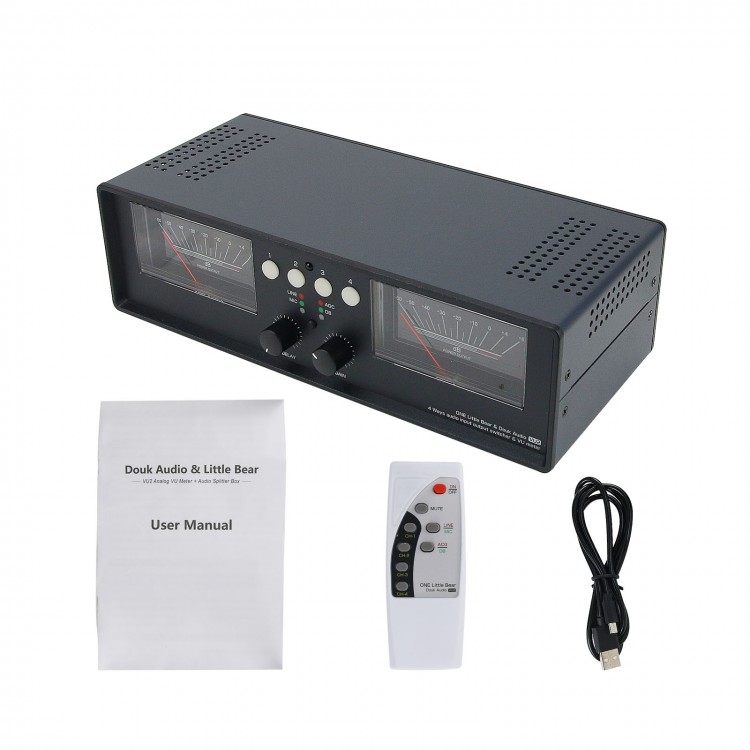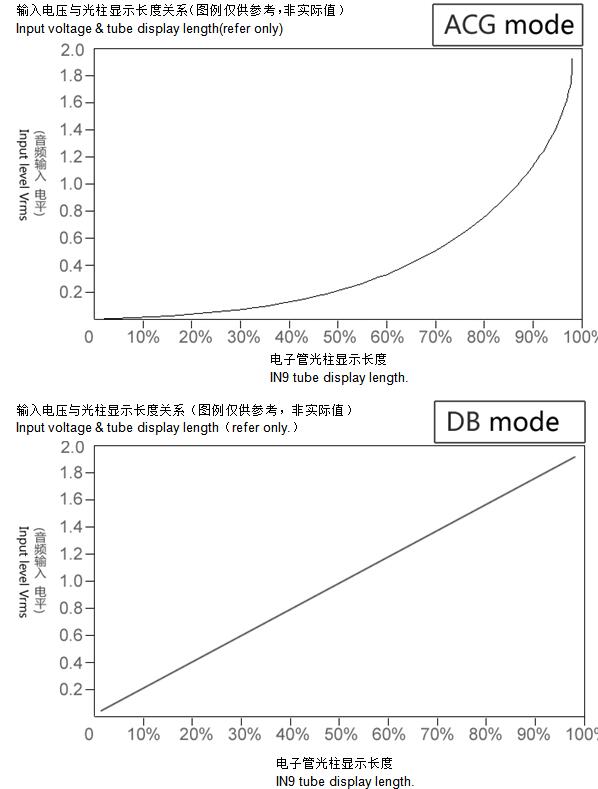
| Quantity | 3+ units | 10+ units | 30+ units | 50+ units | More |
|---|---|---|---|---|---|
| Price /Unit | $165.62 | $162.24 | $157.17 | $150.41 | Contact US |
VU2-D LED Version MIC+LINE Dual VU Meter Audio Splitter Box 4-Way Switcher Sound Level Indicator
Version Introduction:
* VU2-L Bulb Version: White background meter + tungsten bulb orange backlight. Classical model.
* VU2-D LED Version: Black background meter + LED white backlight. Fashion model.
Description:
By
default, the machine has set the mode as the most commonly used mode.
Buyers only need to turn DELAY and GAIN knobs to their favorite beating
speed.
It is a multifunctional VU level meter, which integrates
4-way audio switcher + double large VU meter level meter, which can meet
the needs of most buyers. Buyers can easily connect to multiple audio
sources to share a set of large VU level meters to display music bounce
effects. It is no longer necessary to re-plug and unplug cables, which
is very convenient to manage your audio system. It also supports remote
control.
In addition to single channel switching function (that
is, only one channel can work at the same time), the 4-way audio
switcher also supports the simultaneous operation of all channels, that
is, 4 channels can work in parallel at the same time. If you input 4
audio signals at the same time (4 IN and 1 OUT), then you can set 4
signals to be output to I/O channel at the same time to achieve the
purpose of mixing. If it is 1 IN 4 OUT, then it is possible to output an
audio signal to multiple devices at the same time, such as recording or
monitoring. I/O port is connected to your player, and the other 4
groups of signals are simultaneously output to each device, one group is
input to computer for recording, one group is output to amp, and the
other group is output to monitor speakers. The setting method is also
simple. Press and hold the channel key that needs to work at the same
time for 2 seconds until the channel light is on. Press the buttons of
channels to work at the same time.
Note:
It is recommended to use parallel output function when 1 IN and 4 OUT,
that is, connect 1 player and 4 different outputs. It is not recommended
to use the parallel function when 4 IN and 1 OUT, it may cause sound
distortion.
All input and output interfaces are all
copper and long gold-plated RCA interfaces, with excellent electrical
performance, large contact area, and minimal signal loss. Good materials
can ensure good sound quality.
In order to maximize the
potential of VU meter, original dynamic acceleration and deceleration
damping modes have been specially added, which can make the rhythm of
pointer beating better. In addition, the most commonly used and most
practical functions are designed directly in front panel, so that
everyone can quickly set to the best working state. These functions are:
1.
DELAY: Used to set the speed of pointer jumping. It can be adjusted to a
suitable speed according to the speed of music. It will be better
visually. Suggestion: slower music with slow rhythm, faster music with
faster rhythm. All settings are displayed in real time , And reference
signal is the input audio signal, be sure to input music when adjusting.
2.
GAIN: Used to set the gain of input signal. This GAIN setting is not
adjusted by using a potentiometer to attenuate the audio through a
resistance attenuating the input signal. This way will affect the audio
source somewhat. It is digitally adjusted through MCU. GAIN's
potentiometer has no physical contact with input audio signal.
Therefore, the effect on audio signal is 0, which is a digital gain.
Through this GAIN knob, you can set the pointer jump range. If the input
signal is too small, it can be increased appropriately. If the input
signal is too large. It can also be reduced appropriately. In short,
users can set the pointer of the meter in an optimal beating range. In
addition, some users who need to record can also set their own 0dB
position to monitor recording volume.
3. VU Meter Function Keys:
3.1.
One-Click: Select the VU meter audio input method, there are two types:
microphone pickup / LINE IN. Buyers may choose the best method
according to the actual situation. It is recommended to use the LINE IN
method if accurate display is required. This display is the most direct
and true. If it is not convenient to connect the cable, you can choose
MIC mode.
3.2. Double-Click: Select gain mode as DB or ACG. The
difference between the two is explained in the figure below. It is
recommended that ordinary users choose ACG, which has the best beating
effect, and DB can be chosen for recording studios or special occasions.
4. Turn On/Off Dynamic Damping Mode:
It
can only be set via remote control. The method is as follows: first
press MUTE button on the remote control, and then press ACG/DB button.
At this time, the ACG/DB LED will flash to indicate that this function
is turned on or off. When setting, music is playing at the same time,
and DELAY and GAIN knobs are turned to at least 50%, you can clearly
distinguish the difference between the two modes from the music swing
rhythm. After selecting the mode, press MUTE to exit the setting.
This
machine is powered via USB interface and can be connected to any USB
charger. USB only supplies power to driver board, and has no
interference to audio input and output circuits. The functions of VU
meter and 4-way switcher are independently controlled. The VU meter only
reads signals from the I/O port of switcher, as far as possible to
ensure that the sound quality is not affected.
Specifications:
- Size: 28 x 12 x 9 cm (LxWxH)
- VU Meter Audio Input Mode: support stereo RCA or microphone pickup mode
- Audio Output: 4-way stereo RCA
- Working Voltage: Micro USB, DC 5V 0.5A (VU2-D), DC 5V 1.5A (VU2-L)
- Backlight Filament Voltage: DC / AC 6-12V 100mA (only for VU2-L Bulb Version)
- Backlight Filament Current: 10mA (only for VU2-D LED Version)
- Remote Control Function: support
- Switcher Working Mode: 1 IN 4 OUT or 4 IN 1 OUT
- Pointer Sensitivity Adjustment: support manual quick adjustment
- Gain Adjustment: Support manual quick adjustment
- Gain Mode: DB or ACG. (Note: DB is generally used for recording occasions, ACG is used for most common occasions)
- Dynamic Acceleration, Deceleration Damping Mode: support
- Switch Function: support
- Set Power-off Memory: support
-
Mute Function: support (Note: If switcher is working in 1 IN 4 OUT
mode, the meter will keep beating in silent mode. In 4 IN 1 OUT mode,
the meter will stop when silent.)
ACG & DB Mode Description:
1.
In ACG mode, the VU meter is driven by an exponential compression
algorithm, which means that the relationship between input volume and
pointer swing is not proportional. It can be seen from the relationship
graph that when the input volume is low, the pointer swings more widely.
When the volume gradually increases, the swing amplitude of the pointer
gradually decreases. In this mode, users can use the VU meter in a
larger audio input range without adjusting the gain, and at the same
time obtain a good display effect. When the pointer jumps with the
music, even if the volume input is too small, the pointer will jump,
even if the volume input is large, it will not reach the maximum swing.
It is recommended to adjust GAIN to make the pointer swing as close as
possible to 0dB.
Because it uses an exponential compression
algorithm to drive the pointer, it cannot really display the current DB
level of the input volume, which is not suitable for professional
recording occasions. But this mode is suitable for people's regular
hearing habits. Because human ear hears the sound and the loudness of
the sound has a ratio, not 1:1. For example: a 20W speaker and another
100W speaker, their power ratio is 5 times. If the meter head actually
jumps, there should be a 5 times angle change. But the human ear does
not sound like this, people only feel that the sound is only about 2
times different in loudness. That is, the sound of the 100W speaker
seems to be only about twice as loud as the 20W speaker (meaning that
the 100W speaker is only 40W, which is not the case). This is the actual
difference. So in this case, if the pointer jumping range is about 2
times, the human vision and hearing can match. Feeling more comfortable.
But if it jumps according to the real value, the pointer jumped 5 times
the angle, which caused the sensory misalignment, which made it
relatively uncomfortable. (Only for some people, not all situations.)
2.
In DB mode, the VU meter pushes the pointer to jump after standard AD
conversion. The data has not undergone any changes and is the most
original. So the swing of the pointer is proportional to the input
signal. An analogy (not actual test data): If the audio signal input
0.1V pointer swing angle is 10 degrees, then input 0.7V. The pointer
will swing 70 degrees. In this mode. The beating of the signal and the
pointer is 1:1. For some occasions that need to know the real music
level, such as a recording studio or testing a certain sound level, this
mode can be selected.
Attention:
- When setting
sensitivity, there must be music input. Otherwise the pointer will not
jump. It is impossible to see the actual effect of current setting
value. Double-click and single-click the function keys. Operate at the
speed you usually operate computer. When you click to select, there will
be an appropriate delay, which is the program designed. This is normal.
-
When using microphone to pick up the sound, according to the volume of
the speaker or the distance between VU2 and the speaker. Properly adjust
the GAIN knob to get a better beating effect.
- It is recommended to
use a separate USB charger for power supply, not to use the USB on
audio machine. For example, after connecting computer audio source, it
is not recommended to use computer USB again. Because it is easy to
generate common ground noise.
Package Included:
- 1 x Assembled UV Meter
- 1 x USB Power Cable
- 1 x Remote Control
- 1 x Instructions
Note:
- Power supply is not included in the package.
- It is assembled and ready to use.